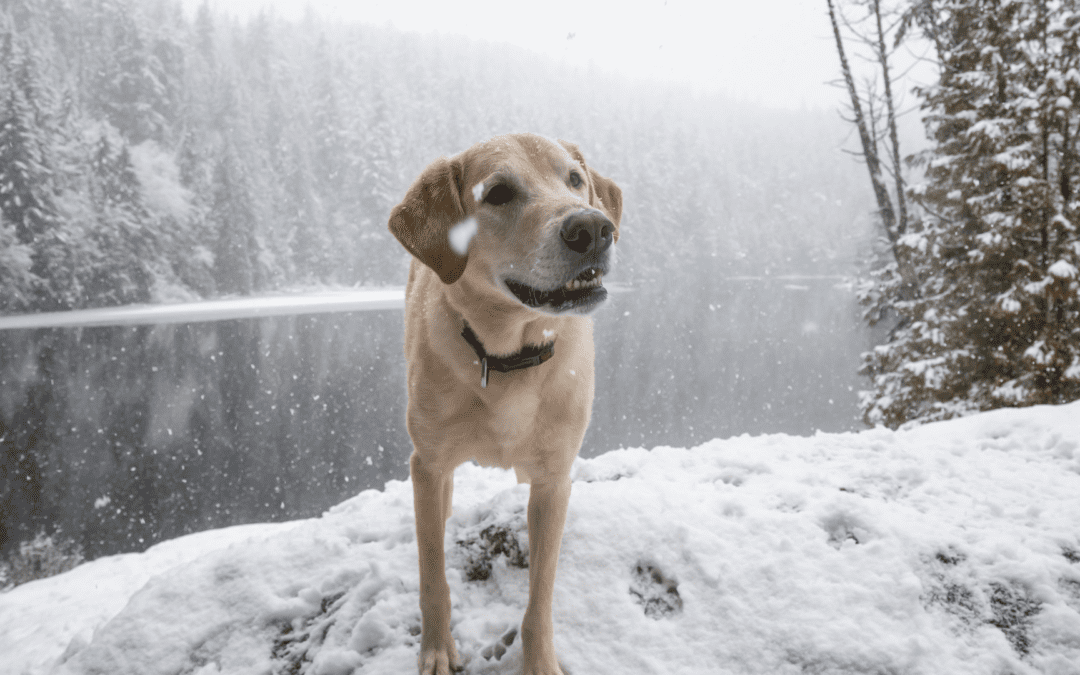1. Understanding the Impact of Cold Weather on Dogs
Knowing how the cold affects dogs and how to prevent these problems is essential for every pet parent. Here are some typical difficulties that dogs could experience:
Osteoarthritis
Dogs are able to develop arthritis just as people do. While it often affects older dogs, it can happen to any dog. Cold weather may make arthritic symptoms worse, making it harder to jump, walk, sit up straight, or stand. Dogs with arthritis may be restless even when they are sleeping.
Cracked and Swollen Paws
Paws may get chapped and swollen when the cold weather is combined with substances like de-icing salt from the road. Due to the possibility that dogs may lick their paws in an effort to feel better, these situations might cause skin infections.
Weight Gain
Reduced activity brought on by the cold, especially in regions with a lot of snowfall, may lead to weight gain. Unwanted weight gain can happen if a dog’s activity pattern is disturbed but their calorie intake stays constant. This may cause further health problems including worse arthritis or the emergence of diseases like diabetes mellitus.
Anxiety
When these activities are restricted due to the cold, dogs who like outdoor activities like swimming or hiking can get nervous or disappointed, leading to stress and anxiety.
Frostbite
Without adequate protection, dogs that wander outside in cold weather risk developing frostbite. The very low temperatures in this situation might harm the skin and underlying tissues. Breeds of dogs with bald hairs or short coats are more susceptible.
Hypothermia
Long-term cold exposure may cause hypothermia, which is characterized by an extremely low body temperature. Breathing problems, decreased blood flow, and even a coma may arise can develop.
2. Can Dogs Handle Cold Weather Better Than Humans?
Depending on the particular dog and the traits of their breed, dogs may manage cold weather differently. Some canines are more suited to colder areas by nature. Breeds with more substantial paws and thicker hair, particularly those with a thick undercoat, often perform better in colder climates. These dogs often don’t need to wear heavy winter attire and could even like playing in the snow.
3. Recognizing When Your Dog Is Cold
It’s important to be able to identify signs of cold-induced discomfort in your dog. Look out for the following indicators:
Shivering
If your dog is shivering, it’s a clear sign that they’re feeling cold. Shivering is a natural response to try to generate warmth.
Shallow Breaths
Cold weather may lead to shallow breathing in dogs. If you notice your dog having difficulty breathing, it may be due to the cold.
Fatigue
Very cold temperatures can leave dogs feeling unusually tired.
Stiff Muscles
Your dog’s muscles may appear stiff, making movement seem more challenging.
Pale Skin
Cold weather can sometimes cause the skin to appear paler than usual.
4. Understanding Paw Irritation in Snowy Conditions
Your dog’s paws may be sensitive to the cold temperatures, leading to potential irritation. Several factors can contribute to this:
Ice Formation
Ice can accumulate around the paws and between the toes, resulting in irritation and potential abrasions.
Chemical Irritants
Chemicals, such as de-icing salts, commonly used in snowy conditions can lead to paw irritation.
5. Safe Snowy Walks for Your Dog
Yes, it is safe for dogs to walk in the snow. However, if your dog will be exposed to snow for an extended period, consider investing in appropriate cold-weather shoes. These will help protect their paws from the cold and potential irritants like de-icing salt. To combat paw irritation in snowy conditions, take the following steps:
Booties
Ensure your dog wears properly fitted booties. These will shield their paws from the cold and potential irritants. After walks, be sure to wipe their paws with a towel.
Limit Walk Duration
Keep walks relatively short to minimize prolonged exposure to the cold.
6. Using Winter Coats for Dogs
In very cold temperatures, it’s strongly recommended to outfit your dog with a winter coat. The coat should be comfortable, allow unrestricted breathing, and be the correct size for your dog.
7. Providing Blankets for Your Dog
Blankets are an excellent way to offer your dog extra warmth, particularly in indoor environments. Assess the temperature in your home and consider whether your dog would benefit from an additional layer of warmth.
8. Adding Extra Warmth at Home
If you believe your dog requires more warmth, consider the following options:
Personal Space Heater
Use a safe space heater in the area where your dog rests. Ensure it’s pet-friendly and won’t cause thermal burns if touched. Adjust the settings to maintain your dog’s comfort.
Heating Pad Precautions
While heating pads or electric blankets can be useful, they pose a risk of thermal burns to dogs. Place layers of blankets on top of the heating pad and avoid direct contact.
Fireplace
If you have a fireplace, use it to create a warm and cozy environment for your dog. This is especially effective if the fireplace is located in a common area where your dog can still interact with the family.
10. Limiting Outdoor Exposure
The length of time a dog can safely stay outside in the cold varies depending on factors such as temperature and the dog’s breed and physical characteristics. It’s advisable to err on the side of caution and limit outdoor exposure during very cold weather.
Conclusion
Finally, assisting your pet in acclimating to cooler temperatures involves knowledge and planning. You may take proactive measures to protect your dog’s well-being throughout the winter by being aware of the possible effects of cold weather on their health and comfort. Your efforts may assist your furry friend have a secure and pleasant winter, whether it’s by providing suitable clothes, shielding their paws, or giving a warm indoor environment.

